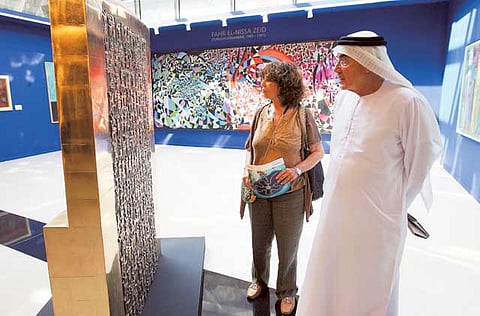Middle East demand for contemporary art on the rise
Christie’s highest valued lot has a base price of between $3 and $4 million

Dubai: Art enthusiasts have to dig deep into their pockets to buy Fahr El Nissa Zeid’s Break of the Atom and Vegetal Life.
The 1962 oil on canvas modern art painting has a base price of between $3 (Dh11 million) and $4 million and is the highest valued lot in the Middle East at Christie’s, who twice-yearly auction being held October 29 and 30.
Modern creations are not an easy find, according to Michael Jeha, managing director of Christie’s in the Middle East.
“On the modern side, it’s getting harder and harder to get top quality modern works by these dead artists. The supply is shrinking,” Jeha said.
In the last five to ten years, modern art paintings have been sold to private collectors, museums and institutions, who do not want to re-sell them, explained Jeha. Modern and contemporary is the theme for this season.
Paul Guiragossian’s colourful piece, painted in 1988, is among the prominent works on show. It projects the sentiments of suffering, misery and depression that resulted from Lebanon’s civil war. It has a base price of between $600,000 and $800,000.
Another highlight is a bronze six ft. sculpture by Parviz Tanavoli. Oh Persepolis II’s sister piece, called Oh Persepolis (The Wall), fetched $2.8 million when it was sold in 2008, achieving a world auction record price for any Middle Eastern artist.
The base of Middle Eastern buyers has increased over the last five to six years, which reflects the region’s growing appetite for art, says Jeha.
“More people are buying art. If you look at the gallery scene five or six years ago, there were seven or eight galleries, there are now 50 or 60 galleries in Dubai alone- that’s a clear indicator of the growth in demand for art. We’re also seeing more art fairs and museums in the region,” he said.
He also said that more international collectors are getting their hands on Middle Eastern art. Regional demand is growing as well, with more buyers from Saudi Arabia.
Similarily, Colin Beaton, managing director of Limelight Creative Services, a retail consultancy, said that international luxury brands view the Middle East as an area to grow their business. “Demand for luxury goods in this region is very very strong,” he said.
Strong demand has helped Christie’s sell over 85 per cent of the works last season, bringing in over $6 million, according to Jeha.
He expects continued market growth in the next ten years.
Christie’s has sold over $200 million worth of art, including more than 2000 works from the Middle East, since it began its first auction in Dubai in 2006, he said.
Meanwhile, regional buyers are putting their money on other luxuries, namely watches and jewellery, according to him.
“That’s one of the reasons why we brought the watches auction back,” he said. Christie’s Middle East first introduced watches to buyers in 2007, but they were removed, since in the last two years Christie’s “hasn’t sold watches,” he said.
There are 50 watches this season, which are sourced from around the Middle East. Among these are a Rolex ring watch, a wristwatch with a Europe and Asia dial, valued at $140,000, and a Patek Philippe range of watches dating back from the 1940’s to the 1960s, estimated to be valued between $20,000 and $40,000.
Sign up for the Daily Briefing
Get the latest news and updates straight to your inbox



